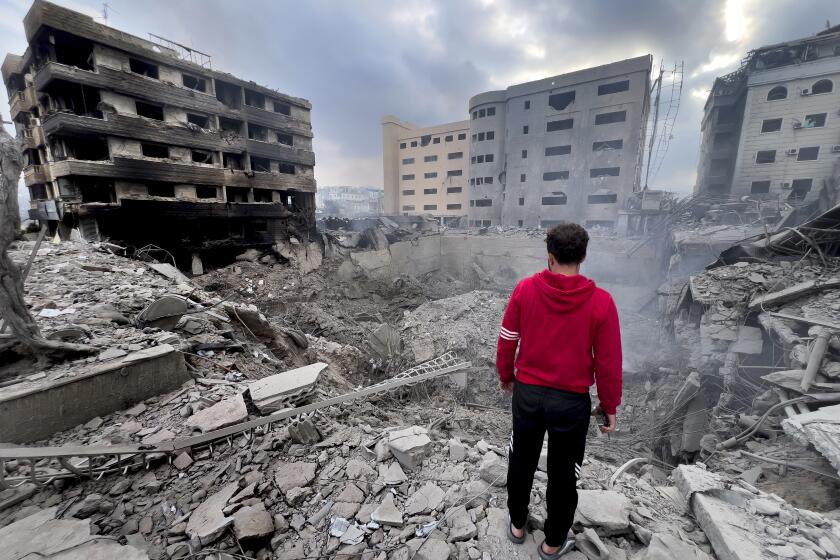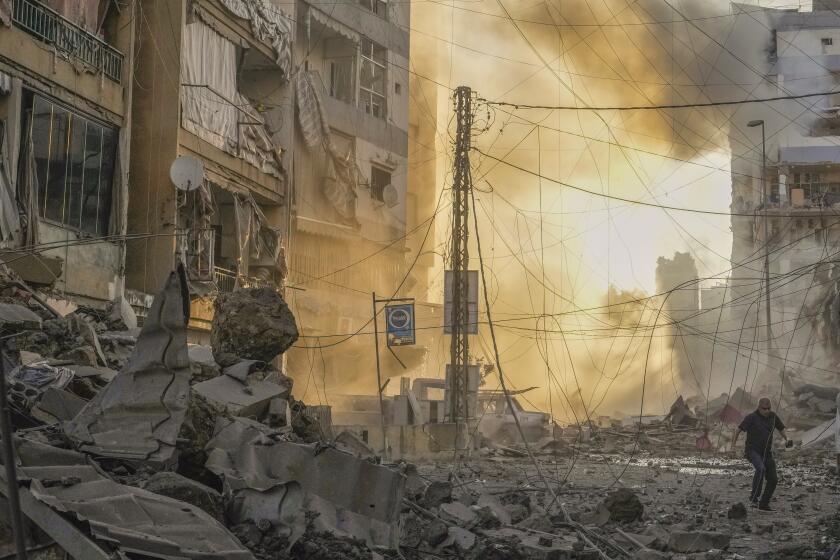Israeli officials demand the right to strike Hezbollah under any cease-fire deal for Lebanon
- Share via
JERUSALEM — Israeli officials on Wednesday demanded the freedom to strike Lebanon’s Hezbollah as part of any cease-fire deal, raising a potential complication as a top U.S. envoy was in the region attempting to clinch an agreement.
The development came as an airstrike hit the historic Syrian town of Palmyra, killing 36 people, according to Syrian state-run media, which blamed the attack on Israel. The Israeli military declined to comment.
Israeli Defense Minister Israel Katz and Foreign Minister Gideon Saar each said Israel sought to reserve the right to respond to any violations by Hezbollah under an emerging proposal, which would push the militant group’s fighters and Israeli ground forces out of a U.N. buffer zone in southern Lebanon.
There have been signs of progress on the cease-fire deal. On Wednesday, Hezbollah leader Naim Kassem said the Lebanese militant group supports the ongoing negotiations but has “some reservations” and rejects a provision for “freedom of movement” for Israeli troops in Lebanon.
“In any agreement we will reach, we will have to maintain our freedom to act” if there are violations, Saar told diplomats in Jerusalem.
Hezbollah critics and supporters alike are voicing frustration over what many view as the group’s miscalculations.
Katz said “the condition for any political settlement in Lebanon” was the right for Israel’s military “to act and protect the citizens of Israel from Hezbollah.”
Amos Hochstein, the Biden administration’s point person on Israel and Lebanon, has been working to push the sides toward agreement and meeting this week with officials in Lebanon. He said Wednesday he would travel to Israel to “try to bring this to a close if we can.”
The emerging cease-fire deal would push Hezbollah and Israel out of southern Lebanon
Hezbollah began firing into Israel on Oct. 8, 2023, in solidarity with Hamas after its attack on southern Israel that sparked the war in the Gaza Strip. Israel has been responding with strikes in Lebanon, and dramatically escalated its bombardment in late September by launching a ground invasion just inside the border.
In more than a year of exchanges, more than 3,500 people have been killed in Lebanon, most in the last month, the health ministry reported, and more than 1 million people have been displaced. It’s unknown how many of the dead were Hezbollah fighters. On Wednesday, 11 more were killed across Lebanon, according to the ministry and Lebanese state media.
In Israel, more than 70 people have been killed by Hezbollah fire, and tens of thousands have fled their homes. Israeli police said a Hezbollah rocket fell outside an empty kindergarten Wednesday in the northern city of Acre, causing damage but no injuries.
Israel carried out a new strike in Beirut, which it said killed a senior Hezbollah commander, and the militant group launched dozens of rockets into Israel.
Hochstein’s proposal is based on a United Nations resolution that ended the 2006 war between Hezbollah and Israel. It stipulates that only the Lebanese army and U.N. peacekeepers should operate in southern Lebanon.
Still, Hezbollah never fully ended its presence in the south. Lebanon accuses Israel of also violating the resolution by maintaining hold of a small, disputed border area and conducting frequent military overflights.
Israel says that Hezbollah has since built up a military infrastructure in villages and towns in southern Lebanon.
The current proposal would include an implementation plan and a monitoring system to ensure each side follows its obligations to fully withdraw from the south. That could involve the United States and France, but details are still unclear.
There’s been progress, but no done deal yet
The Israeli ministers didn’t outline details of Israel’s demand to maintain freedom of operation. Since the 2006 war, Israel has struck Hezbollah on the few occasions when border violence flared up, but any large-scale response could push the region back into turmoil.
Israeli jets have struck multiple buildings in Lebanon’s southern coastal city of Tyre, sending large clouds of black smoke into the air.
It’s unlikely Lebanon would agree to a deal that permits Israeli violations of its sovereignty. Hezbollah leader Kassem said Wednesday that any cease-fire must include “a complete and comprehensive end to the aggression,” preserving Lebanon’s sovereignty and ruling out any freedom of movement for Israel in Lebanese territory.
Though the proposal attempts to nail down an implementation mechanism, the failure to fully implement the U.N. resolution after the 2006 war could point to difficulties in getting the sides to uphold a sustainable cease-fire that would bring long-term quiet.
Israel has continued to pound Hezbollah, and rockets have continued to rain down on northern Israel. Any perceived escalation could derail the talks.
The war in Gaza would grind on even if Israel, Hezbollah reach cease-fire
The war in Gaza is now in its 14th month as Israel battles Hamas in the territory. The Palestinian death toll there has soared to nearly 44,000 — at least half of them women and children, according to local health officials, who do not distinguish between civilians and combatants in their count.
Israel carried out a series of massive airstrikes Friday, hitting suburbs of Beirut and cutting off the main border crossing between Lebanon and Syria.
Fifteen people, including five children and three women, were killed in strikes in the Gaza Strip on Wednesday, according to an Associated Press journalist who counted the bodies at hospitals.
Hezbollah has said throughout the war that it won’t stop firing at Israel until the fighting in Gaza ends, but that condition was dropped in September after Israel intensified its offensive on the militant group, killing its top leadership and degrading its military capabilities.
That leaves Gaza waiting for a cease-fire of its own as a humanitarian crisis has displaced much of the territory’s 2.3 million people and prompted widespread hunger, especially in the north, where the U.N. says virtually no food or humanitarian aid has been delivered for more than 40 days because of the Israeli military’s siege.
International mediation has stalled repeatedly amid disagreement between Israel and Hamas over whether the war should end as part of a cease-fire deal, with Israel insisting it wants to maintain troop presence in certain areas.
The U.S. on Wednesday vetoed a U.N. resolution calling for a cease-fire in Gaza because it was not linked to an immediate release of hostages taken captive by Hamas.
Israel said it hit more than 1,110 Hezbollah targets in Lebanon. Lebanese officials said 492 people were killed.
Hamas ignited the war in Gaza when its fighters stormed into Israel on Oct. 7, 2023, killing some 1,200 people, mostly civilians, and abducting about 250. Around 100 hostages are still inside Gaza, at least a third of them believed to be dead.
Other tumultuous areas of the Middle East probably won’t be affected by a Hezbollah-Israel cease-fire, including Syria.
Israel frequently targets military sites and facilities associated with Iran-linked groups in Syria but rarely acknowledges the strikes. The death toll from Wednesday’s strike in Palmyra was unusually high.
The Syrian Arab News Agency said that along with the 36 killed, the strike on Palmyra also wounded more than 50 people and caused “significant material damage to the targeted buildings” and the surrounding area.
Palmyra is known for the historic Roman temple complex nearby, but it wasn’t immediately clear if the ruins were damaged. The complex suffered significant damage years ago, during the Islamic State group’s rampage across Syria.
Goldenberg and Chehayeb write for the Associated Press and reported from Jerusalem and Beirut, respectively.
More to Read
Sign up for Essential California
The most important California stories and recommendations in your inbox every morning.
You may occasionally receive promotional content from the Los Angeles Times.















